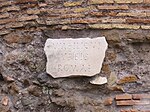Basilica Porcia
180s BC establishments2nd-century BC establishments in Italy2nd-century BC establishments in the Roman RepublicAncient Roman building and structure stubsAncient basilicas in Rome ... and 1 more
Roman Forum

The Basilica Porcia was the first civil basilica built in ancient Rome. It was built by order of Marcus Porcius Cato in 184 BC as censor and is named after him. He built it as a space for administering laws and for merchants to meet, against some opposition. It stood to the west of the Curia, on land bought by Cato and previously occupied by shops and private houses. Many trials were held inside the basilica. It was destroyed by fire after the body of Publius Clodius Pulcher was alit on a pyre in the adjoining senate house in 52 BC. The ruins were probably flattened later that year to build a new building on the site.
Excerpt from the Wikipedia article Basilica Porcia (License: CC BY-SA 3.0, Authors, Images).Basilica Porcia
Via del Tulliano, Rome Municipio Roma I
Geographical coordinates (GPS) Address Nearby Places Show on map
Geographical coordinates (GPS)
| Latitude | Longitude |
|---|---|
| N 41.8933 ° | E 12.4848 ° |
Address
Santi Luca e Martina al Foro Romano
Via del Tulliano
00184 Rome, Municipio Roma I
Lazio, Italy
Open on Google Maps






